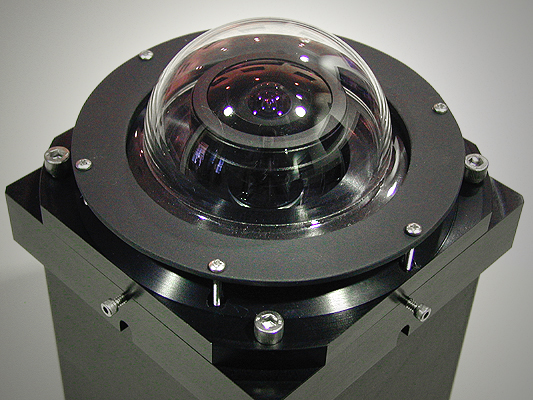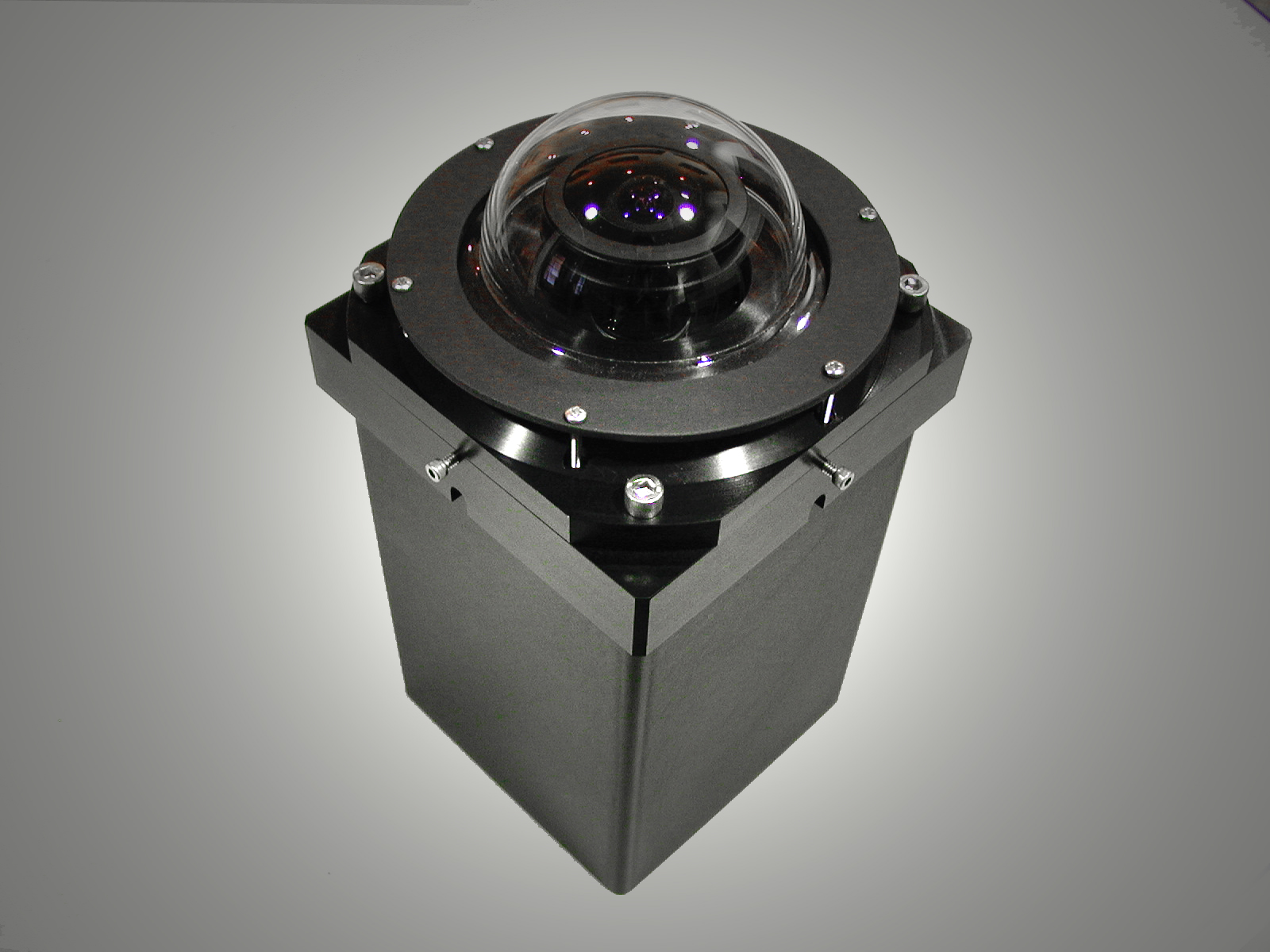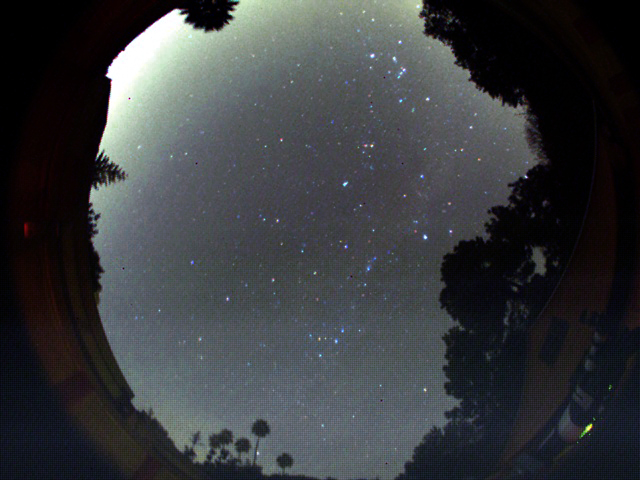
New Product Announcement
SBIG’s New All Sky Cameras
November 4, 2008
Updated: February 4, 2009
$2195 with fisheye lens, $1695 without lens
SBIG is now accepting pre-orders for estimated release late May /early June
See details below

The AllSky-340 and AllSky-340C
SBIG is about to release our new All-Sky cameras, the AllSky-340 and AllSky-340C. The model 340 is a monochrome camera and the model 340C uses a color CCD. This will be SBIG’s third version of a weatherproof AllSky camera for monitoring weather conditions. The first had to be obsoleted when we stopped production of the ST-237A, and the second went obsolete when the lens we were using became unavailable, with no suitable replacement. With each version we gain some knowledge and this is our best one yet. The sensor is the Kodak KAI-340 CCD, with 640x480 pixels, 7.4 microns square, and a high gain output stage for excellent sensitivity. The camera electronics and CCD are from the soon to be released Smart Guider camera, our new autonomous guide camera. The All Sky camera will precede the guider since the software task is easier and is essentially done at this point.
The All Sky camera incorporates the Smart Guider Camera inside an aluminum enclosure with an acrylic dome to protect the fisheye lens. The fisheye lens is Fujinon's new FE185C046HA-1, with a 1.4 mm focal length, F/1.4. We have tested this lens and the image quality is excellent wide open, all the way to the horizon. Figure One below shows an All Sky camera image with the Fujinon lens and KAI-340 CCD. The exposure was 60 seconds from a light polluted backyard – the first quarter moon had just set behind the roof.
Figure One: All Sky Camera Image

One of the challenges of an All Sky camera is that the moon is in the field of view literally half of the time, averaged over a month. The reflections from within the dome and lens can interfere with detection of stars. Figure Two is an image taken earlier in the night, with the dome in place, that has been DDP scaled to show the stars and the sky close to the moon. Some ghost reflections are visible, but the image quality is excellent.
Figure Two: Image earlier in Night with First Quarter Moon in Field

The new All Sky camera has some very interesting features that make it much more versatile than our previous offerings. First of all, it has an RS-232 link to the PC for control and image download. While this interface is very slow in comparison to USB, it will tolerate 100 foot (30 meter) cable runs. Or, you can throw away the cable and use a bluetooth wireless link with an optional inexpensive adapter. And, the unit is low power and can be powered by a solar array (also optional) so you don’t any wires AT ALL running from your PC to the camera! The beauty of this is now the unit can be located where it has a good view of the sky, instead of good access to a power plug or PC. Your roof is now the preferred location, above the trees and neighbor’s houses.
By actual test, an RS-232 link, using a USB to RS-232 adapter running at 460.8 Kbaud, with a 100 foot cable, downloads a full image reliably in 15 seconds. At 115.2 Kbaud a full image takes 60 seconds. Bluetooth wireless adapters will typically run at 115 K-baud, and the one we have tried here worked reliably at a distance of 75 feet. With wireless links, one must minimize the number of walls you have to pass through. Each wall (2 layers of dry wall or wood) costs about a factor of two signal and range.
These may seem rather long download times compared to the USB 2.0 interface of our last AllSky camera, but the new AllSky-340 can take an image while transmitting, so with exposures longer than the download time the camera is only insensitive for the length of the readout of the CCD, which takes place in less than 1 second to an internal memory buffer in the camera. As a result, the camera is excellent for meteor detection. Its field of view is wider than our previous meteor camera, so it should see many more meteors near the horizon. One other plus – the software can run continuously in the background while you use your computer for other tasks. At these slow download rates the computer workload is so slight your applications won’t even notice. It will not interfere with regular imaging using the same PC. The All Sky image is there when you want to view it.
The housing is illustrated in Figure Three. The fisheye lens is mounted to a plate which can be translated, tipped, and focused relative to the CCD, so the full resolution of the lens can be achieved. This plate is also heated, to keep the lens free of condensation. The heat rises into the acrylic dome, warming it and keeping off the dew, and drying off raindrops. The inexpensive acrylic dome is easily replaced by removing a few screws, allowing for routine replacement in the field as the dome suffers the inevitable scratches and damage due to sunlight, windblown dust and disrespectful birds. SBIG will maintain a supply of replacement domes. The prototype shown here is black – the production version will have a white body so it doesn’t get too hot in the sun. It is 5.5x5.5x11 inches in size (14x14x28 cm).
Figure Three: Weatherprood All Sky Camera Housing

At the time of this writing it appears we will offer a color version of this product using a KAI-340 CCD with a color matrix. This can produce dramatic images, as shown in Figure Four.
Figure Four: Color All Sky Image

This camera can also take exposures as short as 50 microseconds, so daylight operation is possible, allowing recording of cloud conditions 24 hours a day. A blooming streak will be noted vertically through the sun, but otherwise the image is excellent.
SBIG also intends to modify the existing meteor camera software to support this new camera and enable bright meteor detection and recording while you sleep. Iridium flares, space station overflights, and brighter satellites will also be captured, along with the occasional “What is that?”! We think the new All Sky camera will provide a very useful tool for the amateur with an automated setup trying to avoid clouds, those users interested in watching for fireballs, and those who simply wish to capture movies showing the beauty of the sky rotating endlessly over their heads. The software has the ability to capture .AVI files and display them afterwards. The file storage requirements are around 72 megabytes a day for 24 hours coverage, one frame a minute.
A sample movie is shown below
(you must have windows Media Player to see this). The sequence begins
about 6:30PM with a bright moon in the sky and shows the entire night until
about 8:00AM the next morning including moon set and sunrise from a relatively
bright urban site. There is a time stamp in the upper left corner.
The green background is due to the auto contrast display pushing up the
brightness during the night and showing up the light pollution reflecting from
thin clouds over the test site. Please note this movie is compressed for
web display and the level of compression affects the image quality.
Uncompressed images from the camera are seen elsewhere on this page. If
you Windows Media Player does not play this movie you may need to download the
DivX codec here:
http://www.divx.com/divx/windows/download/index.php